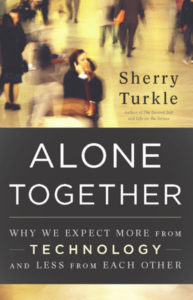
One of the most familiar idiom’s used in popular U.S. culture has been the saying, “as American as apple pie.” Ironically, thanks to companies such as Apple and Google that saying may no longer ring true for simple depictions of American symbolism. Today, more than ever America and most of the Western world is connected to some form of networked technology.
In her book Alone Together, author Sherry Turkle looks at the phenomenon created by technology on the lives of everyday citizens. While we are more connected than ever via the internet, emails, social media, and texting, Turkle argues that we have grown further apart from each other as a society of humans in need of human intimacy and interaction. Humans today spend more time engaged and connected to technological devices than they do with intimate one on one interactions, as a result we are less social.
Written in two parts, Turkle explores the use of robotic companionship that has been introduced as a way to address loneliness by seniors and others in need of social engagement in part one. In addition, we are also introduced to computer applications that allow individuals to create entirely separate cyber lives that offer fulfillment without the normal obligatory requirements. Both are clear examples of how we have increased our connectivity, but oddly become more alone.
Part two of the book takes a much deeper look into the relationship that exist between humans and their devices. From cell phones, laptops and desktop computers Turkle raising the concern that we are seldom if ever “not on.” The emotional connections that exists between technology and the users of it have begun to create unhealthy outcomes for both young and old. Our public spaces have been invaded by the “always on” users of technology. Turkle uses several examples of persons she’s interviewed about specific situations that have arisen as a result of their use of technology. Young teen agers sense a desire to have their emotional needs met by simply informing others that are connected. Other youth sense a loss of authentic relationship and quality time spent with parents who are consumed by devices necessary for work. How did we get here? And why do we expect so much from technology and so little from actual people? These are a few of the major questions raised in Alone Together that will spark the thoughts and imaginations of preachers trying to address a resistant group of millennials.
This new way of relating has become very common in our midst. But something is amiss, says Turkle. I would argue that it’s the silence that has permeated every other social fabric of our society. We seldom speak out with regards to those things in culture that tend to take us closer to the edge of chaos and dysfunction. We see, yet we say nothing. We see it in our homes when our children hardly speak to us after coming home from school. We see it when our spouses head straight for the home office after having left the business office. We see it public spaces when people pass us by without the courtesy or gesture of a greeting. We see it in our schools, our businesses, community meetings and even in our churches. We see it, but we say nothing.
The answers are not all that easy. As I read of Turkle’s interactions with her daughter I could not but help to reflect upon time spent with my own children. The reality is that as a non-custodial parent I only have my daughters every other weekend. I have them for approximately two days. And much of that valuable time is spent with all three of us deeply engrossed in our smartphones. Turkle again argues that we are “tethered” to these gadgets and their offspring. They are the first things we see when we awake and often the last things we see before we go to bed.
I would have to agree with one assessment made in the book and that being that a large number of people in the professional world tend to feel as though a high volume of communication on these devices somehow signals productivity. And while that may be true to a large extent I’m not so sure that it’s conducive to extended external relationships with other human beings. I can’t begin to tell you how many youth athletic events I’ve attended only to see parents totally disengaged from their children’s activity. Even worse are the people who miss out on an evening of live entertainment because they are busy trying to get the perfect picture or selfie of the performance.
I think this is an excellent book for faith leaders in exploring the trends and activities driving human discourse and interaction. Particularly, for congregations like the one I pastor in Lanham, Maryland where the aerage member is over 55 and disconnected from the social media world. They often argue that we should go back to the way things were. NOT GONNA HAPPEN! Unfortunately, I don’t think we are going back to the way things used to be, but I would suggest that we begin to TALK about the concerns raised by Turkle, in this book, before we forget how to do that.






